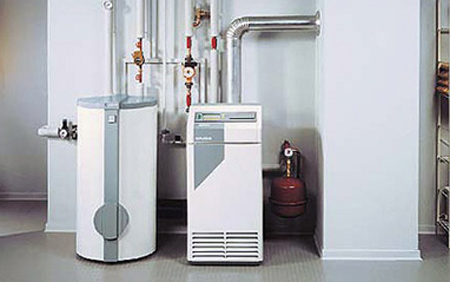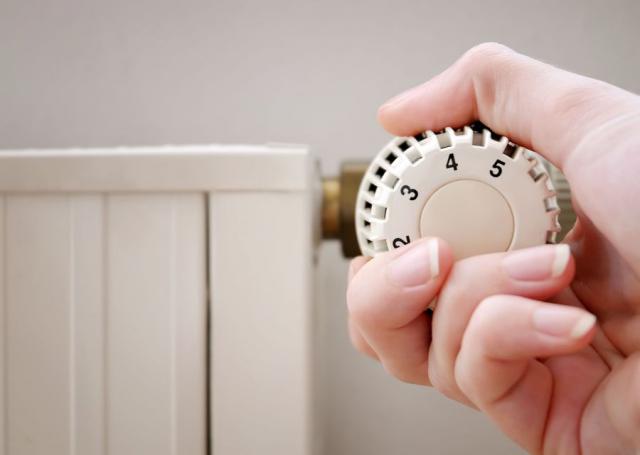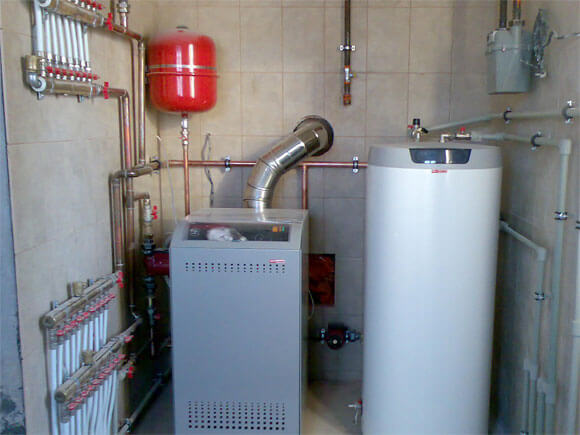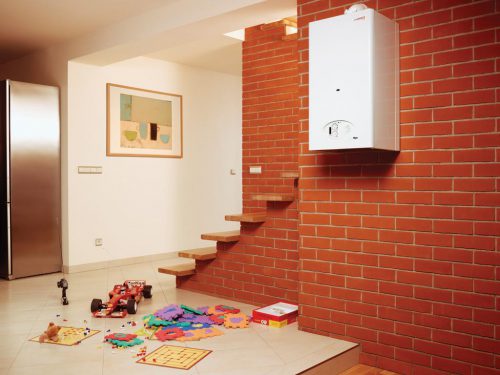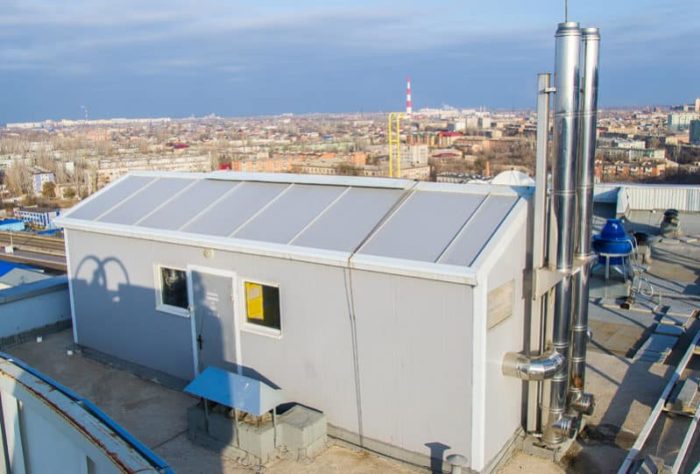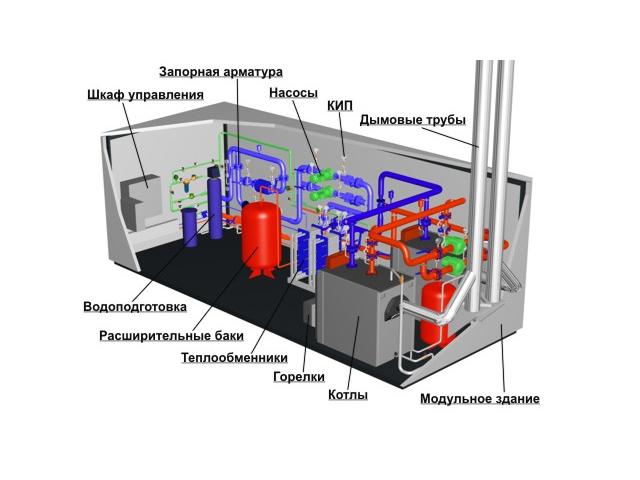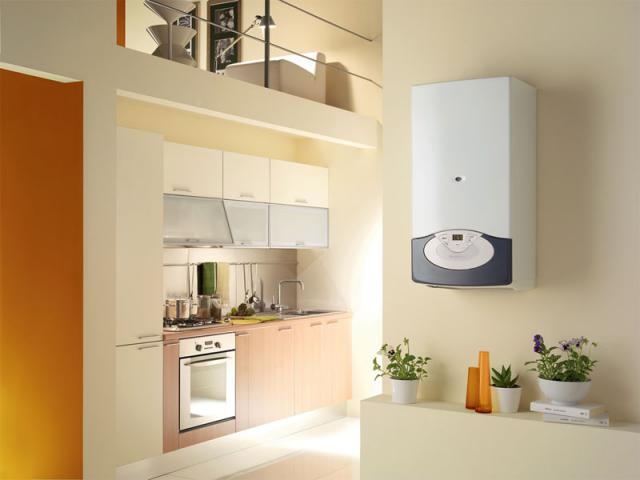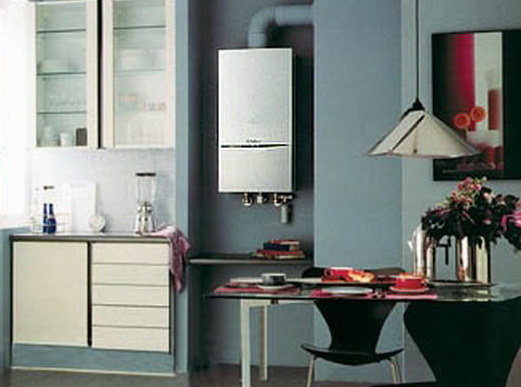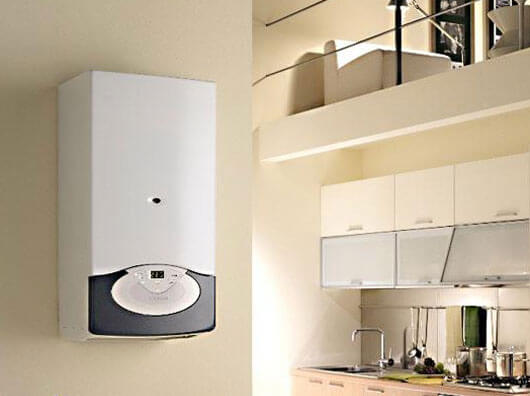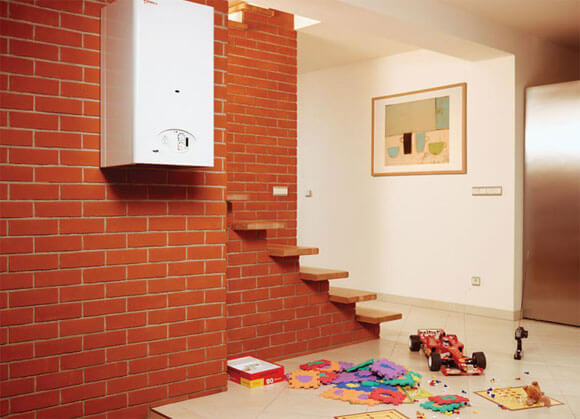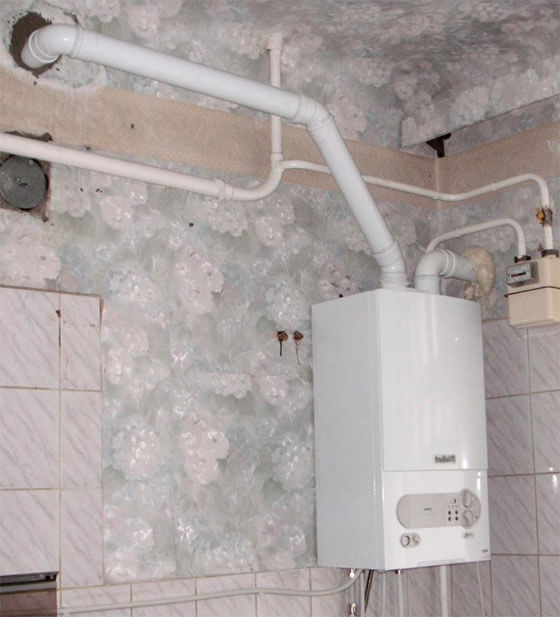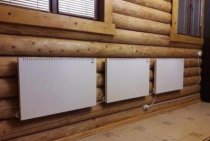Pros and cons
Advantages
Let's take a closer look at the second option and determine its positive and negative sides. To begin with, let's figure out what an autonomous heating point is. This is a separate room where boiler equipment is located, the power of which is enough to provide heat and hot water to the entire apartment building. This is a kind of mini-boiler room with a full range of necessary appliances, fixtures and systems. Modern technologies for providing heat to residential buildings began to be used in autonomous systems. The latter worked for one or more houses, which was doubly beneficial. Why?
- Firstly, the distance from the heat generator to the heating devices in each apartment has been significantly reduced. This means that heat losses have decreased due to the transportation of the coolant.
- Secondly, the time of heat supply to the consumer was reduced, which is again associated with a decrease in distance.
- Thirdly, the costs of maintenance of heating networks, their repair and installation have changed downwards.
- Fourth, the economic performance stemming from previous benefits has declined. This means that the cost of the supplied coolant has changed to a minimum.
Autonomous System Diagram
There is another advantage of the system. When a house is being built, the developer is required to obtain a large number of permits that will allow him to crash into the central highway.
Bureaucratic delays sometimes take more than one month. Yes, and the installation of a meter will cause a lot of disputes between developers and the host, that is, the operating company. So for builders, the option with, even for the largest house, is ideal.
And the last advantage - the boiler house for the microdistrict occupies a place where not only buildings and water tanks will be erected, but also an electrical substation, access roads, warehouses, office buildings, office buildings and so on. That is, under it will have to allocate a fairly impressive area. And if there is no need for a boiler room, the district administration can use this area for its own needs. For example, to build another residential building, a school, a clinic, and so on.
Flaws
gas boilers
Cons exist in any system, but they are usually less:
- An autonomous boiler room should be located in a separate building, so it is necessary to allocate a site near the house for it. Sometimes such a building looks like an extension.
- Mini-boilers pollute the environment to a certain extent. Therefore, modern cleaning devices are indispensable here. And being inside microdistricts obliges to create conditions for environmentally friendly performance indicators. They exist and are stipulated by the norms and rules of SNiP. Hence the increase in the cost of the equipment itself.
- An autonomous heating system is not yet as popular as a centralized one, so the production of equipment and related components has not yet been put on stream. Hence the high cost of such systems. So, not all developers can afford them.
Heating regulator
However, experts say that engineering developments today can eliminate some of the shortcomings. For example, if an autonomous boiler room is used to heat only one apartment building, its equipment can be placed in the attic - the dimensions of the devices allow this. In addition, the attic immediately becomes heated, which is undoubtedly a plus. In addition, the area in the territory between the houses is freed up. The only requirement for such options is the presence of a flat roof, which is not a problem.If you plan to install just such a heating system, then you can add a flat roof to the project. Experts have already carried out preliminary calculations, which showed that even if the cost of equipment and installation costs are high, all this will pay off in a few seasons.
Documentation and its difficulties
If usually the amount of money for the service acts as a catalyst for all problems, then in the case of autonomous heating it is the collection of all necessary confirmations and installation permits.
In addition, permission may not be obtained at all, since officials are very reluctant to meet halfway and can simply stall the issue, especially if the apartment in the house is the only one claiming heating independence. If a refusal occurs, then it is imperative to convene a commission, which, with the support of independent experts, will have to justify the decision of the public utilities and make a final verdict.
On the other hand, if the house is not an apartment building, but its own, then the problems become an order of magnitude smaller. This is due to the fact that you can simply contact the installation company, which will solve all the problems: from obtaining the necessary documents to installing the boiler.
Gas roof boiler
The device has the following positive aspects:
- High efficiency. Thanks to the use of liquefied gas, which releases energy when heated, fuel consumption is reduced.
- There are almost no external communications. This reduces the cost of funds. Heat loss is also reduced.
- In low buildings (up to 26 m) there are no additional installation requirements, which reduces the cost of the project.
- Automation, which reduces the cost of operation.
- The device is not turned off for an annual check, which allows daily use of hot water.
The device has several limitations. To accommodate the boiler room, the roof is strengthened by installing a concrete pillow. Pre-calculate the load that the building can withstand.
For installation, they bring special equipment, the work of which creates inconvenience to residents. The cost is also unpleasant: the costs go to the creation of the project, the laying of the gas carrier, the automation responsible for control. Additionally, protective measures and a fire extinguishing system are installed.
Benefits of Autonomous Systems
Autonomous heat supply of an apartment building has many advantages for its owners:
- The heat supply of an apartment building is almost completely automated, so you can set a certain temperature regime and it will be observed by the device. In addition, it will be possible to set the minimum temperature parameters in case of departure, so that excess heat will not go into the void.
- Autonomy allows you to depend only on yourself, because the constant pipe breaks at utility companies will no longer turn off the heating. While many will wait for the return of heating, the owner of autonomous heating in the apartment can safely warm up in his apartment.
- The devices undergo technical testing, therefore breakdowns occur extremely rarely and you can fully rely on the heating system and not be afraid to turn off the heat supply at the most inopportune moment.
Electrical heating systems
To date, electrical equipment for decentralized heating is considered the most economical. In the operation of such devices, as a rule, the principle of water polarization under the influence of alternating current is used.
Connecting one apartment involves a simple autonomous system with the installation of an electric boiler with an anode operating principle. The use of dual-circuit systems implies the possibility of arranging underfloor heating through a separate circuit.For small rooms, the best option would be special batteries with individual heating, which allow you to independently adjust the heat indicators.
A more complex process is the transfer of the entire residential building to an autonomous electrical system. To do this, you should first resolve issues with the substation, calculate the expected load on the power grid in accordance with the power of the transformer. If necessary, switchgears should be replaced. This event must be coordinated with the energy company.
Important! Most older systems and wiring will not be able to handle the heavy loads. Therefore, in a house converted to autonomous heating, it is recommended to replace incandescent lamps with LED sources, as well as reduce other energy costs.
Gas heating
As a rule, apartment owners have a choice between two types of alternative heat sources:
- Designs based on a gas boiler.
- Electrical heating systems.
Gas heating has several advantages:
- Modern boilers are equipped with an increased security system and operate autonomously. maintaining the level of heat that residents need.
- These boilers are small. therefore they can be installed in even small rooms.
- It is easy to mount, so with due attention and some tools and skills, even a beginner can do it.
- Autonomous gas heating in the apartment is equipped with a chimney system and it does not have to be carried out separately.
- Gas boilers operate absolutely silently. so that they will not cause complaints from neighbors.
- Affordable price and complete equipment with all components and parts make gas heating the most common choice among consumers.
When installing a new heating, the old system must be dismantled. It is easier and cheaper to install new radiators than to try to fit old ones to it. Although modern gas boilers have the highest degree of protection, gas leakage is still possible.
Useful functions of an automated autonomous system
Almost every autonomous heating system is equipped with a number of functions that greatly simplify the life of its owners:
- Automated systems can distinguish between sudden changes in outdoor temperature, adjusting the indoor climate as needed. Thanks to this, even in the absence of the owners of the dwelling, the temperature will not drop, and the boiler will start heating the water in time.
- If the outside temperature rises, the system will reduce energy consumption while maintaining the same indoor temperature.
- Automatic systems are able to reduce performance during the day and at night, but at the same time they pump heat in the evening and in the morning, when it is most needed. Thanks to this, a pleasant temperature regime is created in the room, and fuel is not consumed unnecessarily.
- The system can be equipped with a room temperature sensor. To do this, it is installed in rooms that are not combined with the boiler room. If there is a change in temperature, the heating system starts up and regulates the temperature in the right direction.
Selection of fuel and boiler
Gas is most often used for an automatic heating system, as it is one of the cheapest natural resources. In addition, many boilers are designed specifically for it and can be placed both on the floor and on the wall.
As for the boiler itself, the key choice here is between cast iron or steel equipment.
Steel boilers are susceptible to corrosion, and therefore are not as durable as cast iron models. On the other hand, it is much easier to mount a steel unit than a cast iron unit due to the weight of the device. In addition, a steel boiler is much easier to hang on the wall, which is why most of these models are made from this material.
How to calculate the cost of autonomous heating, see an example in the video:
Procedure for disconnecting from a central heating system
When preparing all the necessary documents for the transition to individual heating of housing, it is necessary to study the relevant legislation:
- Federal Law No. 190 of July 27, 2010;
- Decree of the Government of the Russian Federation No. 307 of April 16, 2012;
- Art. 25, 26 of the Housing Code of the Russian Federation.
The easiest solution would be to install an electric boiler. You just need to make an application and transfer it to the district electrical network. Under appropriate technical conditions, a permit will be issued quickly. But the heat generated in this case may exceed the cost of thermal energy from centralized heating.
Therefore, the installation of a gas boiler is more beneficial in terms of cost savings, since the cost of natural gas is relatively low. But when carrying out individual gas heating, you will have to comply with many formalities:
In the city gas service, you must obtain the appropriate technical conditions.
Check the chimney for serviceability and get a conclusion about this from the All-Russian Volunteer Fire Society (VDPO).
Get the consent of the other residents of the house (this item is spelled out in part 3 of article 36 of the Housing Code of the Russian Federation)
This is very important, because in case of failure of one apartment from centralized heating, failures in the operation of the entire system may occur. In addition, it is necessary to raise the relevant documents and find out who owns such elements of the system as batteries and pipelines.
If they are in common house ownership, it is also necessary to issue a special permit from the neighbors. If the heating components are not common property, permission to turn off must be obtained from the management company.
In urban heating systems, get the right to dismantle the heating system in your apartment.
For those residents who have gas water heaters installed in their apartments, it will be easier to obtain permission for individual heating, since such buildings have a chimney, and the pressure in the gas pipeline is suitable for the operation of a gas boiler.
Having received a preliminary permit for a gas heating project, the following documents should be prepared:
- An application in which it is necessary to indicate that the owner of the apartment plans to make individual heating and disconnect from the centralized system.
- The original technical passport of the apartment, which should indicate the location of the batteries and pipes.
- Permission from the residents of the house (if the system components are common property) or from the management company.
- Decision on the possible redevelopment of the apartment. It is issued by the Housing Office or the management company.
The term for obtaining permission to dismantle a centralized system and equip an individual one can last from 3 months to six months. After permission is received from representatives of the public utility, you can proceed to the dismantling of the heating elements in the apartment.
Selection of pipes, boiler and radiators
The operation of the entire system depends on the correct choice of the boiler.
For example, if water heating requires the installation of a boiler, then you can get by with the option of a single-circuit gas boiler.
Making a choice in favor of gas heating, it is better to purchase a boiler made of cast iron or a special durable metal. Although they are heavy, they will last much longer.
But pipes for such a heating system are suitable for polypropylene or metal-plastic. as a budget option, and copper, if the wallet allows it.
With radiators, you also have to decide in advance. Today, bimetallic heating radiators have gained great popularity among consumers.
Which ones are actually better for an apartment can be determined by the amount of their heat transfer, for example:
Before buying radiators, it is necessary to calculate in advance how many sections will be required for each room. To do this, the heat transfer of the material must be divided by 100. For example, for a bimetallic radiator, it is 199 W / 100, which equals 1.99 W per 1 m2.
There are several nuances that should be taken into account when choosing radiators and calculating their number:
- If the installation of batteries is supposed to be in a corner room, then 2-3 sections must be added to the results that were obtained in the calculations.
- When decorative panels are installed that hide the batteries behind them, the heat transfer is reduced by 15%, which should be taken into account before calculations.
- Insulated walls or metal-plastic windows can reduce heat loss.
- Installing a meter will allow you to independently regulate gas consumption.
Having made all the calculations and adding to them the cost of the autonomous gas heating system itself, you can make a decision to buy it, or you can compare these figures with electric types of heating.
Installation
To create a heating system on the roof, you need to build a separate room. The roof boiler house is autonomous: having launched it, it is enough to carry out rare scheduled checks.
The process depends on the device variant. There are 2 types - built-in and block-modular.
built-in
Boilers built into the roof are used in new buildings. Such a device is installed only in a building under construction or in a building that has a place to accommodate a thermal station. For built-in boiler rooms, they must calculate the additional load on the walls of a multi-storey building, create a fire extinguishing module.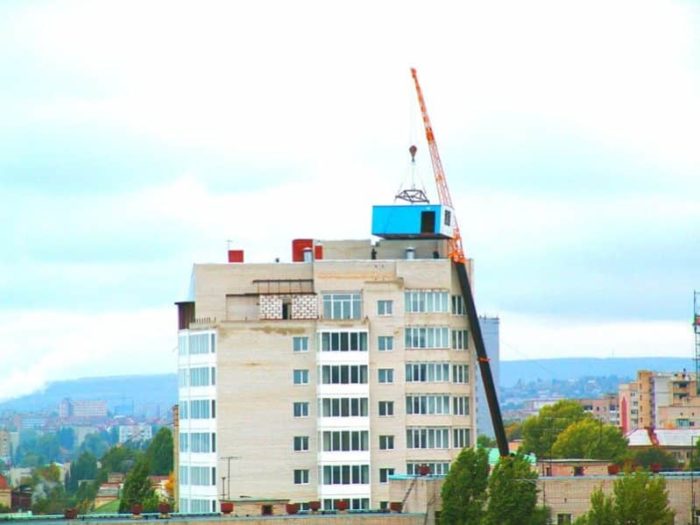
Block-modular
To accommodate the roof boiler house in the constructed building, a block-modular type is used. The most common installation option is during a major overhaul. A roof boiler room is installed in case of restoration of the heating system. The project is created based on the characteristics of the building. Then the device is created and delivered to the required building.
Before installation, a roof audit is carried out:
- Check the condition of the bearing supports.
- Apply a protective coating to the mounting point. They are a concrete pad.
- Carry out the installation of sound-absorbing material.
After completing the preparation, the boiler room is connected to the heating network. It is set up, the coolant is distributed. Having connected to the heating, they begin operation.
What to look out for
Before mounting the device, it must be taken into account that it creates a load on the structure. Because of this, the following rules must be observed:
- It is forbidden to place the boiler room on the floor above the living quarters.
- It is forbidden to place equipment in a room adjacent to a residential area.
- When designing, the size of the house in which the placement is planned is observed.
- When designing, an emergency shutdown system is created.
Advantages
In order for the roof boiler house of a residential building to work stably, it is necessary to carry out careful calculations and not save on installation. Equipped on the roof of the house, it has advantages over other systems:
- Installed on the roof of the house, the boiler room reduces energy losses during the transfer of the coolant from the roof equipment to the radiators. This reduces the cost of heating services by up to 30%.
- Automation serves to use hot water during the absence, when the supply is turned off to check the media.
- Maintenance of the device is reduced due to autonomy. Performance checks are rarely carried out, by agreement with the service company.
- Numerous checks are made prior to operation to detect malfunctions and safety errors.
Varieties of decentralized heat supply
Of course, building a stand-alone boiler room, even a small one, is quite expensive. And the attic option is also not cheap. However, there is an alternative.
Modular boiler rooms
Block-modular boiler house
One of the very interesting projects is modular, or block, boiler rooms. There is no need to build anything, and only a small area is allocated for the boiler room. Blocks are brought here, which are easily and quickly connected into a finished structure.
All of them are completed in the factory, the equipment inside them is precisely matched according to technical indicators, they are insulated and have a presentable appearance.
The most important thing is to correctly arrange and connect the equipment. A couple of days, and the boiler room is ready
But only specialists should be engaged in its assembly. If anyone remembers, such modular boiler houses were used to heat change houses and barracks, that is, temporary structures. After engineers and designers worked on them, such autonomous installations began to be used for organizing heating in apartment buildings. However, this option is not the only one.
Wall mounted boilers
The most efficient and economical today is apartment heating, where wall-mounted boilers are used as a heating device. They run either on gas or electricity. Why wall-mounted?
wall boiler
- Firstly, they are small in size, so they can be installed even in kitchens. At the same time, their appearance does not spoil the interior design at all.
- Secondly, wall-mounted heating boilers are real mini-boiler rooms. Their design includes a circulation pump, an expansion tank, as well as control and safety devices.
- Thirdly, such heating installations can have a power of up to 35 kilowatts, which makes it possible to heat rooms up to 100 square meters with their help.
- Fourthly, modern manufacturers offer both single-circuit and double-circuit boilers for autonomous heating. So you will also be provided with hot water.
And now the important question is how to choose such a boiler? The main thing is to correctly select the unit according to the design features. It should contain all, without exception, the devices that we mentioned - a pump, a tank, and so on. In addition, a chimney is required, which will ensure not only the removal of fuel combustion products in the case of gas boilers, but also the flow of clean air from outside. This means that the wall-mounted gas boiler must be with a closed combustion chamber. And the last thing is full automation, which will not only simplify the operation of the boiler, but also save on fuel.
Of course, with gas boilers there are more problems when connecting. But electrical counterparts in this regard are simpler. Here it is only necessary to draw a branch from the switchboard with the installation of the machine and connect to the water supply system.
What can cause difficulties?
modern kitchen
It may seem that everything is very simple and profitable. Then why aren't tenants switching to this heating system? And no one gives them permission. Imagine that the residents of one house simultaneously submit documents for the re-equipment of heating networks, or rather, for the refusal of the services of organizations supplying heat to houses. This is, firstly, a disaster for such an organization and deprivation of its profits. And, secondly, job cuts, although this issue is controversial. Someone needs to serve autonomous mini-boilers. So, according to many indicators, any of these options is not profitable for management companies. Although on a national scale, the opposite is true. But it is not up to us to decide this issue.
Autonomous heating in an apartment building
Is it possible to install autonomous heating in the apartment with your own hands? Although there is no legal ban on autonomous heating, it is still advisable to consult a lawyer, as some heating systems are banned. For example, water heated floors in apartments cannot be installed due to the fact that they can overload the system, thus depriving other residents of the house of heat.
In other cases, it is required to collect the necessary documents and present them to local authorities:
- registration certificate for housing;
- application for refusal from central heating;
- document on the right of ownership;
- scheme of the new heating system;
- consent of all tenants.
As a rule, such a seemingly simple request, as the refusal of central heating and the transition to the provision of heat itself, turns out to be a lengthy bureaucratic problem.
Even more trouble will be the installation of autonomous heating in an apartment without a permit. This can end not only with a large fine, but also with a lawsuit, so before deciding to equip an apartment with any heating systems, you need to get advice from the relevant authorities and permission for autonomous heating in the apartment.
Schemes for autonomous heating of an apartment:
Advantages and disadvantages
If permission has already been obtained for autonomous heating in an apartment building, then you can proceed to the choice of an alternative type of heat. This is easier to do, knowing the pros and cons of autonomous heating in the apartment.
For the first time, an autonomous heating system for an apartment appeared in Europe. Due to its clear advantages over centralized methods of space heating, it quickly spread throughout the world.
- The main advantage of the system is significant cost savings. The owner of the apartment independently decides when to turn on and when to turn off the heating. For example, today there are thermostats in which you can set a timer for a certain time, which allows you to either completely or partially turn off the system when no one is at home, and turn it on half an hour before the arrival of residents.
- The owner of the apartment can create the necessary microclimate in each room.
- Pay exclusively according to the heating meter and not depend on public utilities and government tariffs.
When making a choice in favor of alternative heat, you need to find out in advance how much autonomous heating costs in an apartment, and what type of heating it will be not only economical, but also efficient.
Among the disadvantages of such a system, the following nuances can be noted:
- Its regular preventive check once a year, for which you need to call a specialist. It's not that expensive, but still, many users either ignore this need or simply forget about it.
- Installing even the best heating radiators for an apartment. be aware of possible heat losses. which are often caused by external walls, unheated rooms from below or poor-quality glazing.
Today, many construction organizations are building residential apartment buildings with ready-made autonomous heating systems. Such housing is in great demand, as it costs a little less and allows the owners to decide for themselves which type of heating to choose.
Layout of the future system
After the final decision is made and the choice is made in favor of autonomy, it is worth contacting a specialist who will help with a number of important issues:
- How best to position the boiler indoors
- What should be its dimensions
- What will be the load on the individual heating system in an apartment building
- How much fuel will the system consume
- How much water will be used for maintenance
Only after solving all these issues, it is worth going to the offices of officials for signatures on a construction permit, otherwise the process of refusal in the very first office is very likely.
The autonomous system itself will consist of the following elements:
- Several convectors;
- Radiators;
- circulation pumps;
- pipes;
- Heating boiler.
In addition, each device differs in the principle of heat output, which can be in the form of:
According to the principle of heat transfer, there are two types of systems: convective and radiant.
If we consider them from the position of circulation, then the following stand out:
- Apparatus with mechanical circulation, which is started by a pump;
- Devices with natural or gravitational circulation, operating on the principle of different heat carrier densities.
Steam heating is also divided into two different heating systems:
For a closed heating system, you will need to select the type of equipment to be installed and only then select automation systems, pipelines, heating boilers and radiators. This is due to the fact that each device has its own characteristics, therefore not every conditional radiator will suit it.
As for automation for the heating system. then it is worth taking its acquisition as responsibly as possible, since it is it that will provide the minimum energy consumption, coupled with the maximum heat transfer. In addition, only good equipment is able to work without failures and provide the desired temperature for long periods of time.
Autonomous heating of an apartment building can be equipped with infrared systems, which are installed everywhere without any problems, and most importantly, they do not require special permits.
